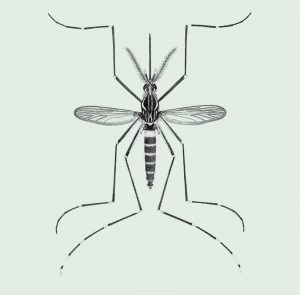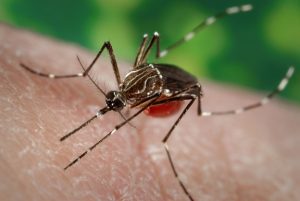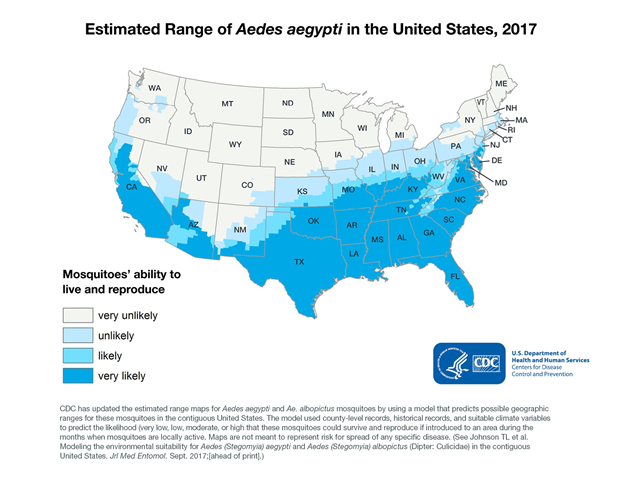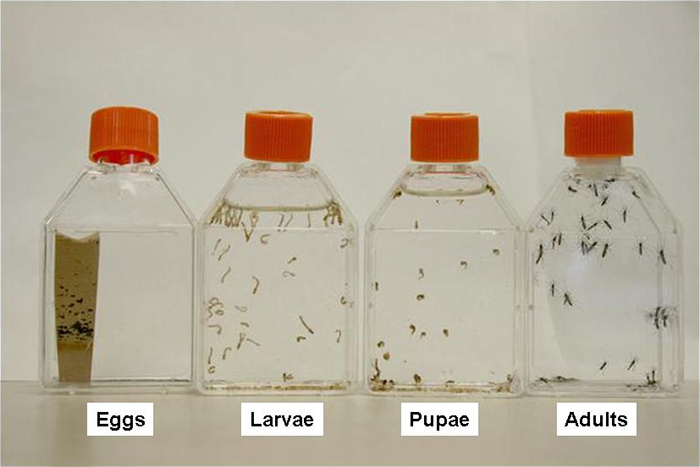Aedes Aegypti
 Aedes aegypti can be recognized by white markings on its legs and a marking in the form of a violin or lyre on the upper part of its thorax (back neck area).
Aedes aegypti can be recognized by white markings on its legs and a marking in the form of a violin or lyre on the upper part of its thorax (back neck area).
Aedes aegypti, also known as the yellow fever mosquito, is the mosquito that has made headlines since 2015 when it was discovered that it is the primary agent responsible for the spread of the Zika virus. In 2015 and 2016, this mosquito spread the virus throughout Latin America and then to other regions. In the United States, it is responsible for spreading Zika in locally transmitted cases in Florida, Texas, and Puerto Rico. It is also the main vector of Dengue in Puerto Rico and was responsible for the yellow fever outbreak in Brazil in 2018 and Nigeria in 2019.
This mosquito’s devastating effect on humans is nothing new. It has killed people through the spread of diseases for tens of thousands of years. In addition to yellow fever, Aedes aegypti transmits West Nile virus, chikungunya, dengue, Zika, and many more. Aedes aegypti has been a problem in the United States since it was first brought here on ships in the early 16th Century. Aedes aegypti was largely eradicated from the US in the 1930s but has been reintroduced in recent decades in overseas shipping containers.
 From its native African forests, this species has successfully colonized many warm climates around the world, including a large swath of the US South, Mid Atlantic Coastal Region, and parts of the Southeast, California, and various other pockets around the US (see map for locations). In fact, it was recently discovered that Aedes aegypti has created a permanent population in the Capitol Hill neighborhood of DC, and there are most likely other permanent populations in other parts of the greater Washington DC area.
From its native African forests, this species has successfully colonized many warm climates around the world, including a large swath of the US South, Mid Atlantic Coastal Region, and parts of the Southeast, California, and various other pockets around the US (see map for locations). In fact, it was recently discovered that Aedes aegypti has created a permanent population in the Capitol Hill neighborhood of DC, and there are most likely other permanent populations in other parts of the greater Washington DC area.
Aedes aegypti are extremely capable of transmitting disease to people since they live near humans and prefer to feed on humans. They are known as peridomestic mosquitoes meaning they live in or just outside the home. They may bite 10 to 15 times before they have a full blood meal, meaning they might bite one person 15 times or up to 15 different people. If anyone the mosquito bites is viremic (meaning the viral levels are high enough in the person’s blood to transmit it to the mosquito), the aegypti mosquito can become a transmitter within a few days. Unfortunately, many mosquito-borne diseases such as Zika are transmitted through mosquito saliva. The first thing mosquitoes do before biting a person is probe where they inject saliva. Therefore an Aedes aegypti mosquito can transmit a disease almost instantaneously to a person and successfully even without having a successful blood meal. Although Aedes aegypti mosquitoes most commonly feed at dusk and dawn, indoors, in shady areas, or when the weather is cloudy, they can bite and spread infection all year long and at any time of day.
 Aedes aegypti are floodwater mosquitoes meaning that they lay their eggs in containers that will fill with rainwater. These can be natural containers such as tree hollows or bromeliads found in their natural habitat or artificial containers such as bird baths, flower pots, rain gutters, children’s toys, or tarps. Aedes aegypti need only a teaspoon of water to lay their eggs and practice skip oviposition where they will lay small quantities of eggs throughout an area in different floodable areas to ensure the survival of their offspring.
Aedes aegypti are floodwater mosquitoes meaning that they lay their eggs in containers that will fill with rainwater. These can be natural containers such as tree hollows or bromeliads found in their natural habitat or artificial containers such as bird baths, flower pots, rain gutters, children’s toys, or tarps. Aedes aegypti need only a teaspoon of water to lay their eggs and practice skip oviposition where they will lay small quantities of eggs throughout an area in different floodable areas to ensure the survival of their offspring.
Due to the many breeding grounds that we humans create, Aedes aegypti has successfully spread from a sylvatic cycle, where they feed on monkeys in the canopy to an urban cycle where they feed on humans. Unfortunately for us, through this process, Aedes aegypti has transferred diseases such as Zika and yellow fever from monkeys to humans.
Aedes aegypti are persistent and furtive feeders. They approach people cautiously and secretly to bite their ankles and the back sides of their arms and legs. While they inject saliva immediately when injecting their proboscis, they will stop feeding and fly away should their victim move. Therefore, they may need to feed 10 to 15 times to successfully achieve a blood meal. This makes them especially dangerous as a disease vector because they can feed on dozens of people to achieve a blood meal and potentially spread disease to all bitten. The fact that Aedes aegypti prefers to feed on humans above other animals explains their success at disease transmission to humans.
Since adapting to urban life, Aedes aegypti will generally stay within the city block that they were born – commonly only traveling a quarter of a mile in their lifetime. They prefer shady and damp areas and bite during the day or early evening. They also like dark colors so wearing light or florescent clothing can help deter them. They will oviposit (lay eggs) 3 to 7 times during their approximate one-month life, and when they do so, they will lay 150 to 200 eggs. These eggs will be spread out across an area with perhaps ten eggs in one floodwater area, 15 in another, and so on. The females literally don’t put all of their eggs in one basket. They will feed 2 to 3 times during their life, but as previously mentioned, each feeding could involve biting 10 to 15 people. They will develop from egg to adult in five days to two weeks, depending on heat and humidity. Hotter and more humid the weather, the faster the development will happen. Aedes aegypti eggs can withstand desiccation. They will remain dry for months and finally hatch when exposed to water. Aedes aegypti overwinter in diapausing eggs – meaning that the eggs will effectively hibernate through the cold months in semitropical climates and hatch in early spring.
Aedes aegypti evolved in the hot and humid forests of Africa and therefore, Aedes aegypti eggs cannot survive extremely cold temperatures. However, by testing the population in the Capitol Hill neighborhood of Washington DC, local entomologists have found that Ades aegypti can survive short stints in frozen birdbaths. Furthermore, their eggs can survive in sewer tunnels, storm drains, underground parking garages, and other areas where they are somewhat protected. This phenomenon explains their permanent populations in cities like Washington DC and other cities further north.
Aedes aegypti have been called the hardest and easiest mosquito to control because people can help limit their breeding by removing areas that can flood with water on their property. Weekly inspection of your property for standing water, no matter how small the amount is recommended. It is also advisable to sign up for regular all-natural mosquito treatments that reduce the mosquito population but do not harm beneficial pollinators like bees.

